Leonids 2007: prediction of activity
to the list of predictions
Introduction
Computation characteristics
We'd like to introduce the results of Leonid meteor stream simulation aimed to the prediction of shower activity in 2007. The simulation was made for the trails of latest 30 revolutions, i.e, from the 1001 trail. The Author used the program by S. Shanov and S. Dubrovsky to calculate orbital elements of ejected meteor particles. To estimate expected ZHRs for different encounters the model by E. Lyytinen and T. van Flandern given in their paper [4] was used with some Author's alterations made in order to adopt the model for ejection velocity (Vej) instead of da0 (difference in a-semimajor axis) as well as to correct fn function to consider factual Leonids activity during recent storms and outbursts. The computation considered only gravitational forces, however, the results are on the whole in good accordance with these of other researchers. The prediction includes all encounters found within interval +/-0.007 a.u. The following parts of trails were computed: the first 5 rev. trails for ejection velocities [-50;100] m/s, 6-10 rev. trails - [-30;50] m/s, 10-20 rev. trails - [-20;30], older than 20 rev. trails - [-10;20] m/s.
Results
The Fig. 1 below shows the distribution of 55P dust trails in the vicinity of the Earth's orbit within the period of 17.08.2007 - 17.02.2009. The vertical axis shows the minimal distance between trails particles and the Earth's orbit. So far, the Fig. 1 displays the moments of passage of minimal distances to the Earth's orbit for various trails and particles and these distances themselves. 1932 and 1466 trails, which give meaningful encounters, are also shown on the Fig 1.
Introduction
Computation characteristics
We'd like to introduce the results of Leonid meteor stream simulation aimed to the prediction of shower activity in 2007. The simulation was made for the trails of latest 30 revolutions, i.e, from the 1001 trail. The Author used the program by S. Shanov and S. Dubrovsky to calculate orbital elements of ejected meteor particles. To estimate expected ZHRs for different encounters the model by E. Lyytinen and T. van Flandern given in their paper [4] was used with some Author's alterations made in order to adopt the model for ejection velocity (Vej) instead of da0 (difference in a-semimajor axis) as well as to correct fn function to consider factual Leonids activity during recent storms and outbursts. The computation considered only gravitational forces, however, the results are on the whole in good accordance with these of other researchers. The prediction includes all encounters found within interval +/-0.007 a.u. The following parts of trails were computed: the first 5 rev. trails for ejection velocities [-50;100] m/s, 6-10 rev. trails - [-30;50] m/s, 10-20 rev. trails - [-20;30], older than 20 rev. trails - [-10;20] m/s.
Results
The Fig. 1 below shows the distribution of 55P dust trails in the vicinity of the Earth's orbit within the period of 17.08.2007 - 17.02.2009. The vertical axis shows the minimal distance between trails particles and the Earth's orbit. So far, the Fig. 1 displays the moments of passage of minimal distances to the Earth's orbit for various trails and particles and these distances themselves. 1932 and 1466 trails, which give meaningful encounters, are also shown on the Fig 1.
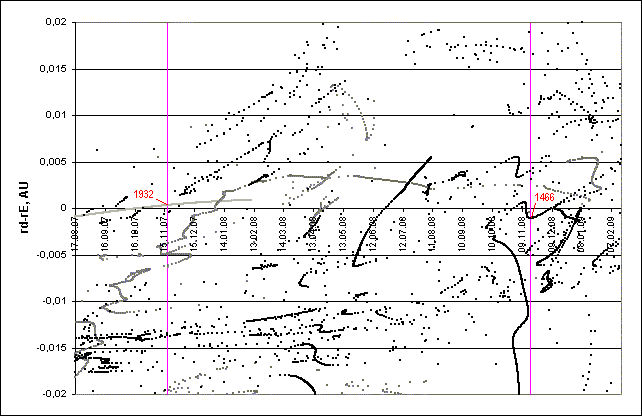
Fig. 1. Space-temporal projection of Leonid trails parts onto their minimal distance passages (correspondence between colours of the particles and their ejection velocities can be seen here).
In 2007 the Earth encounters 1932 trail (earlier this was pointed out by Peter Jenniskens, Esko Lyytinen, Jeremie Vaobaillon). This part of projection is given in the Fig 2 in more detailed scale. It shows the distribution of 55P dust trails in the vicinity of the Earth's orbit within the period of 17.08.2007 - 17.02.2008. The vertical axis shows the minimal distance between trails particles and the Earth's orbit. So far, the Fig. 2 displays the moments of passage of minimal distances to the Earth's orbit for various trails and particles and these distances themselves. 1932 trail, which gives a meaningful encounter, is also shown on the Fig 1.
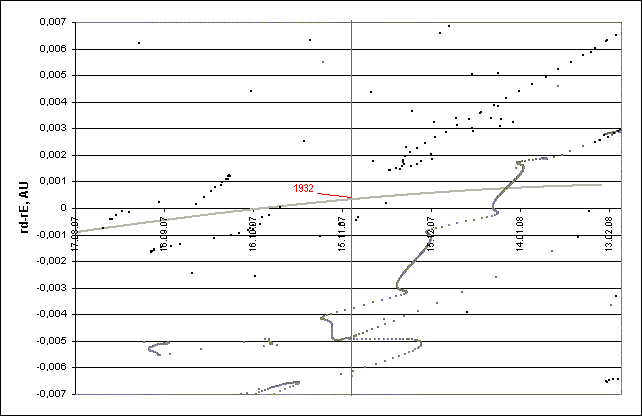
Fig. 2. Space-temporal projection of Leonid trails parts onto their minimal distance passages (correspondence between colours of the particles and their ejection velocities can be seen here).
Assumed activity profile of Leonids 2007 is given on the Fig. 3.
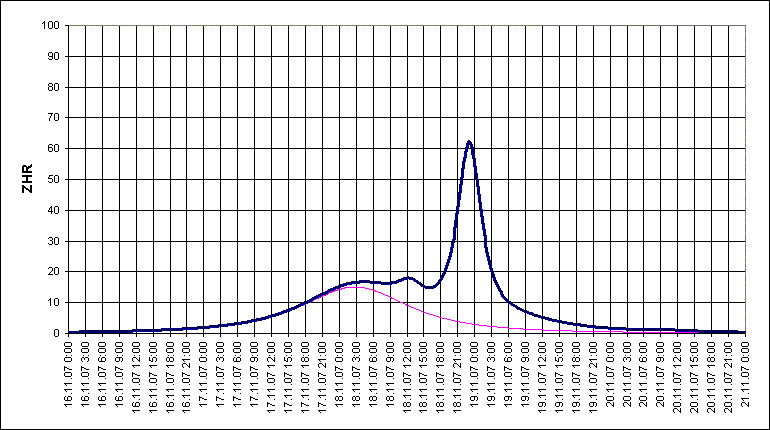
So far we expect, that in 2007 Leonids will give a moderate background maximum, which, along with activity from trail encounters, will produce a plato from the time of background maximum to the beginning of the outburst from 1932 trail. In this period we expect activity on the level of 15-20 meteors on ZHR scale. The
Of course, the most prominent feature of Leonid 2007 will be an outburst from 1932 trail. The Earth already encountered this trail in 2006, the observations allowed to catch maximum intensity of last year outburst, and this result, in the turn, allowed to correct expectations of maximum activity from this trail in 2007. According to the calculations, the maximum is to be reached at 23:05 UT 18 November and its intensity, considering still lasting background activity, will be 60-65 meteors on ZHR scale. Meteor brightness is expected to be considerably below average level, telescopic and radioobservations are recommneded. Reliability of this prediction is very high.

Fig. 3. Assumed profile of overall Leonid activity (blue line) and its background component (red line)
So far we expect, that in 2007 Leonids will give a moderate background maximum, which, along with activity from trail encounters, will produce a plato from the time of background maximum to the beginning of the outburst from 1932 trail. In this period we expect activity on the level of 15-20 meteors on ZHR scale. The
Of course, the most prominent feature of Leonid 2007 will be an outburst from 1932 trail. The Earth already encountered this trail in 2006, the observations allowed to catch maximum intensity of last year outburst, and this result, in the turn, allowed to correct expectations of maximum activity from this trail in 2007. According to the calculations, the maximum is to be reached at 23:05 UT 18 November and its intensity, considering still lasting background activity, will be 60-65 meteors on ZHR scale. Meteor brightness is expected to be considerably below average level, telescopic and radioobservations are recommneded. Reliability of this prediction is very high.
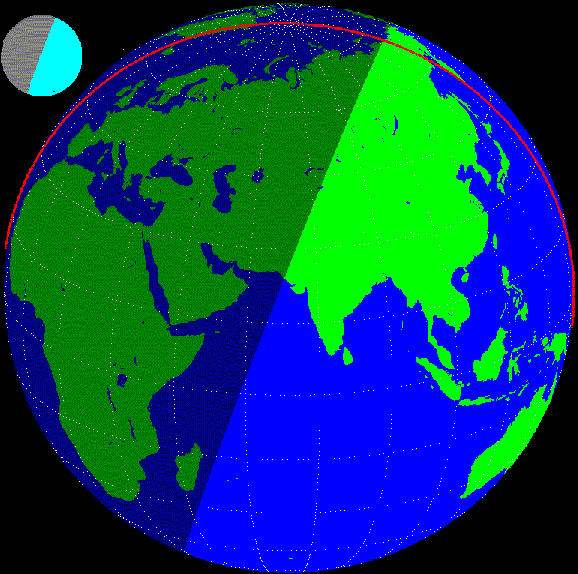
Fig. 4. The Earth as seen from coming Leonid meteors (Radiant: RA=153°, Dec=+22° [IMO data])during the peak at 2:50 UT 18 November [IMO data]. Red line shows the border of hemisphere where the Moon is above horizon (it is shown with in the corner of the Fig. 4 according to its phase).
The Fig. 4 shows the map with regions where this peak would be visible if occured at given time. So far, the best place for observations would be european part of Eurasia, to the weat of Urals, (excluding, perhaps, Pyrenean peninsula and British islands), the Middle East as well as nothern and eastern parts of Africa. Radioobservation will also be possible on all asian part of Eurasia, excluding, perhaps, the territories around longitudes of Kamchatka peninsula.
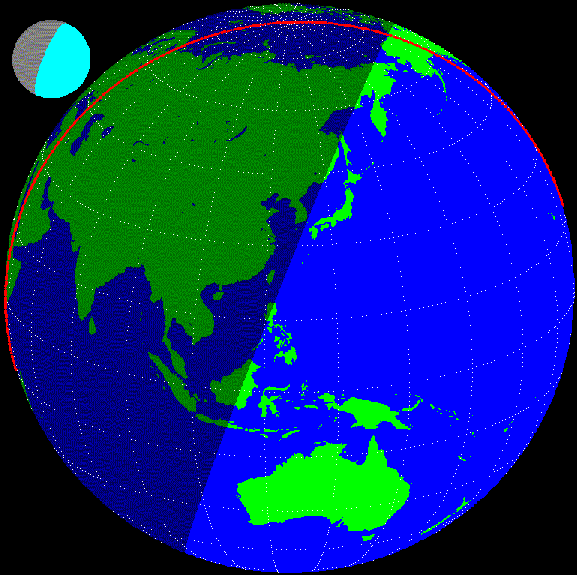
Fig. 5. The Earth as seen from coming Leonid meteors (Radiant: RA=154°, Dec=+21°) during the peak at 23:05 UT 18 November. Red line shows the border of hemisphere where the Moon is above horizon (it is shown with in the corner of the Fig. 5 according to its phase).
The Fig. 5 shows the map with regions where this peak would be visible if occured at given time. So far, the best place for observations would be almost on all asian part of Eurasia, except Russian Far East and eastern coast of China. Radioobservations will be possible on all asian part of Eurasia, as well as on Indjnesian archipelago and in Austalia.
In 2008, as seen on the Fig. 1, the Earth encounters with 1466 trail. Reliability of this prediction is much lower, than for encounters with 1932 trail, however, computations show that there could be much stronger activity outburst - at 0:22 UT 17 November intensity can reach 130 meteor on ZHR scale with meteor brightness above average. Unfortunately, in 2008 the Leonids will be spoiled by moonlight.
Conclusions
In 2007 we expect s moderate background maximum turning to plato on the level of 15-20 meteors on ZHR scale. It wil continue up to beginning of the outburst from 1932 trail. This outburst should reach maximum at 23:05 UT 18 November, with intensity of 60-65 meteors on ZHR scale. Meteor brightness around this outburst will be considerably below average level, telescopic and radioobservations are recommended. The Moon won't create any problems.
References
1. "Comet's dust 2.0" program by S. Shanov and S. Dubrovsky. [Used for orbital computations.]
2. Information from Gary W. Kronk's page http://www.maa.agleia.de
4. Lyytinen E, van Flandern T. "Predicting the strength of Leonid outbursts", 2000, Icarus, P. 158-160.
In 2008, as seen on the Fig. 1, the Earth encounters with 1466 trail. Reliability of this prediction is much lower, than for encounters with 1932 trail, however, computations show that there could be much stronger activity outburst - at 0:22 UT 17 November intensity can reach 130 meteor on ZHR scale with meteor brightness above average. Unfortunately, in 2008 the Leonids will be spoiled by moonlight.
Conclusions
In 2007 we expect s moderate background maximum turning to plato on the level of 15-20 meteors on ZHR scale. It wil continue up to beginning of the outburst from 1932 trail. This outburst should reach maximum at 23:05 UT 18 November, with intensity of 60-65 meteors on ZHR scale. Meteor brightness around this outburst will be considerably below average level, telescopic and radioobservations are recommended. The Moon won't create any problems.
References
1. "Comet's dust 2.0" program by S. Shanov and S. Dubrovsky. [Used for orbital computations.]
2. Information from Gary W. Kronk's page http://www.maa.agleia.de
4. Lyytinen E, van Flandern T. "Predicting the strength of Leonid outbursts", 2000, Icarus, P. 158-160.